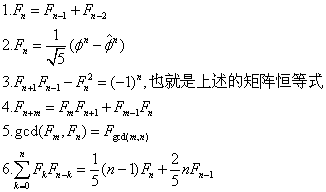From: http://blog.csdn.net/jcwkyl/article/details/3677747
以前只知道使用递归或递推的方法,最近在CSDN论坛上学到一种新的解法,在自己所知的几个算法里,它具有最好的运行效率。这种方法使用下面这个关于Fibonacci数的矩阵恒等式:

这个算法就是根据这个恒等式,通过计算等式右边的那个矩阵的n次方来计算第n个Fibonacci数。n次方的计算使用快速模幂算法,这样计算n次方只用做log(n)次2*2矩阵的乘法,而每次乘法的计算时间是常量。所以,上述方法计算第n个Fibonacci数的时间复杂度是O(log(n))。相比之下,用递归来计算第n个Fibonacci的时间复杂度是O(Fn),是指数时间复杂度的。用递推来计算,是O(n),然而当n很大时,n之于log(n),等于无穷大之于无穷小。
顺便把关于Fibonacci的常用等式再总结一下:

From: http://tieba.baidu.com/p/1890441099
Fibonacci数是组合数学中非常重要的一个数列,它的递推公式是:
F(1)=F(2)=1
F(n)=F(n-1)+F(n-2)
当然,用这个公式来计算F(n)是非常慢的,当计算F(n)时需要从F(1)一直计算到F(n)。Fibonacci数列还满足一些其他的公式,如:
F(a+b+1)=F(a+1)*F(b+1)+F(a)*F(b)
利用这个公式,可以加速Fibonacci数的计算。我们考虑同时计算F(2n+1)和F(2n),则按照上面的公式:
F(2n+1)=F(n+1)*F(n+1)+F(n)*F(n)
F(2n)=F(n+1)*F(n)+F(n)*F(n-1)=F(n+1)*F(n)+F(n)*(F(n+1)-F(n))
这样,F(2n+1)和F(2n)的计算变为了F(n+1)和F(n)的计算,即下标变为了原来的一半。重复利用这种方法,可以每次让下标变为原来的一半,总共需要大约log n次计算(以2为底)。
当n较大时,后面的方法就比直接的递推要快得多,比如当n=1000000时,后面的方法大概需要20次计算,而直接递推的方法大概需要1000000次计算
From: http://blog.sina.com.cn/s/blog_993d2542010143qw.html
现在的问题转换为求矩阵{1, 1, 1, 0}的乘方。如果简单第从0开始循环,n次方将需要n次运算,并不比前面的方法要快。但我们可以考虑乘方的如下性质:
an=
要求得n次方,我们先求得n/2次方,再把n/2的结果平方一下。如果把求n次方的问题看成一个大问题,把求n/2看成一个较小的问题。这种把大问题分解成一个或多个小问题的思路我们称之为分治法。这样求n次方就只需要logn次运算了。
实现这种方式时,首先需要定义一个2×2的矩阵,并且定义好矩阵的乘法以及乘方运算。当这些运算定义好了之后,剩下的事情就变得非常简单。完整的实现代码如下所示。
#include <cassert>
///////////////////////////////////////////////////////////////////////
// A 2 by 2 matrix
///////////////////////////////////////////////////////////////////////
struct Matrix2By2
{
};
///////////////////////////////////////////////////////////////////////
// Multiply two matrices
// Input: matrix1 - the first matrix
//
//Output: the production of two matrices
///////////////////////////////////////////////////////////////////////
Matrix2By2 MatrixMultiply
(
)
{
}
///////////////////////////////////////////////////////////////////////
// The nth power of matrix
// 1
// 1
///////////////////////////////////////////////////////////////////////
Matrix2By2 MatrixPower(unsigned int n)
{
}
///////////////////////////////////////////////////////////////////////
// Calculate the nth item of Fibonacci Series using devide and conquer
///////////////////////////////////////////////////////////////////////
long long Fibonacci_Solution3(unsigned int n)
{
}
From: http://bbs.bccn.net/thread-352527-1-1.html
//2ms AC代码
#include <stdio.h>
struct Matrix
{
int _11,_12;
int _21,_22;
};
void Ride(const Matrix *src1,const Matrix *src2,Matrix *out)
{
out->_11 = (src1->_11*src2->_11 + src1->_12*src2->_21)%10000;
out->_12 = (src1->_11*src2->_12 + src1->_12*src2->_22)%10000;
out->_21 = (src1->_21*src2->_11 + src1->_22*src2->_21)%10000;
out->_22 = (src1->_21*src2->_12 + src1->_22*src2->_22)%10000;
}
void Power(Matrix *src,int n,Matrix *out)
{
Matrix one = {1,1,1,0};
if(n == 1)
{
*out = one;
return ;
}
Power(src,n>>1,out);
Matrix temp = *out;
Ride(&temp,&temp,out);
if(0 == n%2)
return ;
else
{
temp = *out;
Ride(&temp,&one,out);
}
}
int main()
{
int i,j,n;
while(scanf("%d",&n) && n >=0)
{
if(0 == n || 1 == n)
{
printf("%d\n",n);
continue;
}
Matrix m1 = {1,1,1,0},res;
Power(&m1,n-1,&res);
printf("%d\n",res._11);
}
return 0;
}





 本文介绍了一种高效的斐波那契数计算方法,利用矩阵的快速幂运算实现O(log n)的时间复杂度,相较于传统递归或递推算法大幅提升了计算速度。
本文介绍了一种高效的斐波那契数计算方法,利用矩阵的快速幂运算实现O(log n)的时间复杂度,相较于传统递归或递推算法大幅提升了计算速度。

















 被折叠的 条评论
为什么被折叠?
被折叠的 条评论
为什么被折叠?








